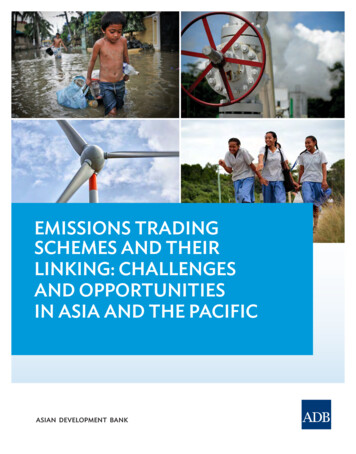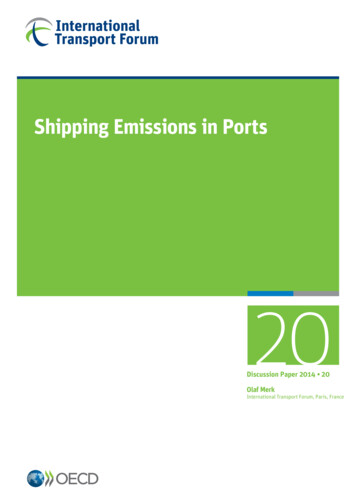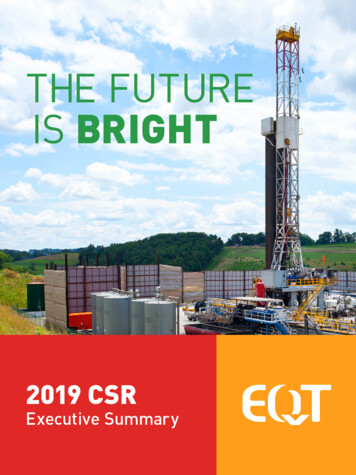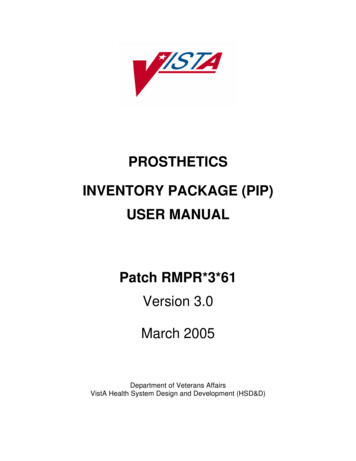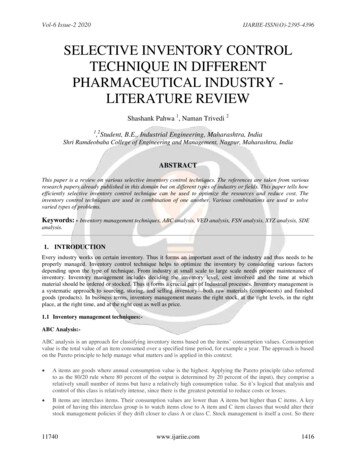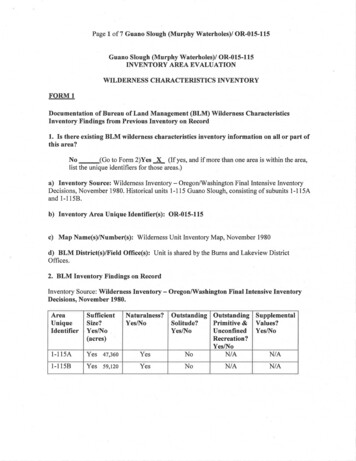
Transcription
Developing Mexico National Emissions Inventory Projections for theFuture Years of 2008, 2012, and 2030Martinus E. Wolf, Paula G. Fields, and Gopi K. ManneEastern Research Group, Inc. (ERG)8950 Cal Center Drive, Suite 348Sacramento, CA 95826marty.wolf@erg.comMaría Tania López Villegas, Veronica Garibay Bravo, and Rodolfo Iniestra GómezNational Institute of Ecology (INE – Instituto Nacional de Ecología)Calle Periférico 500, Col. Insurgentes Cuicuilco, Delegación CoyoacánC.P. 04530, México, D.F., Mexicomtlopez@ine.gob.mxABSTRACTThe 1999 Mexico National Emissions Inventory (NEI) was the first comprehensive municipalitylevel emissions inventory of criteria air pollutants developed for the country of Mexico. However, morecurrent and future year emissions inventory projections are essential to evaluate the future benefits of airquality control measures and to support various modeling analyses in Mexico. Therefore, the WesternGovernors’ Association (WGA) has supported Mexico’s National Institute of Ecology (INE – InstitutoNacional de Ecología) by sponsoring a project to develop future year emissions inventory projections.Also, support for the project was extended by the National Renewable Energy Laboratory (NREL) toevaluate the benefits of air quality control measures in Mexico at the national level.This paper discusses the development of municipality-level emissions inventory projections forthe years of 2008, 2012, and 2030 based upon the 1999 Mexico NEI. Adjustments made to the 1999base year inventory due to municipality divisions are presented. The development of sector-specificpoint source growth factors for electricity generating units, refineries and other petroleum-relatedsources, primary metal facilities, manufacturing facilities, miscellaneous industrial facilities, and servicefacilities is described. The development of area source and nonroad mobile source growth factors basedupon surrogate projections (e.g., population, fuel use, gross domestic product [GDP], etc.) is alsopresented. The results of a detailed analysis of the projected effects of Mexico’s future low-sulfur fuelstandards and new vehicle emission standards on on-road motor vehicle emissions are also incorporatedare also described. This paper also discusses the interactions between the emissions projections andother projects related to greenhouse gases that are currently being conducted in Mexico.INTRODUCTIONBackgroundFuture year emission inventory projections are essential to evaluating the potential benefits of airquality control measures and supporting various modeling analyses. The Mexico NEI projections weredeveloped for Mexico’s National Institute of Ecology (INE – Instituto Nacional de Ecología) in supportof the fourth phase of the Integrated Environmental Strategies (IES) Program sponsored by the U.S.Environmental Protection Agency (U.S. EPA) and the National Renewable Energy Laboratory (NREL)to evaluate the benefits of air quality control measures in Mexico at the national level. Point, area, onroad motor vehicle, and nonroad mobile source emissions from the 1999 Mexico National EmissionsInventory (NEI) were projected to the years of 2008, 2012, and 2030 at the municipality-level.1 In
addition, emission impacts in Mexico due to three control scenarios were developed in consultation withINE.Projections ScopeSince the emission inventory projections were based upon the 1999 Mexico NEI, the scope of theprojections was similar to the Mexico NEI, and included the following characteristics: Source types – Point sources, area sources (excluding paved and unpaved road dust), on-roadmotor vehicles, and nonroad mobile sources. Natural sources (i.e., biogenic and volcanicsources), although part of the 1999 Mexico NEI, were not included in the scope of theprojections.Pollutants – Nitrogen oxides (NOx), sulfur dioxide (SO2), volatile organic compounds(VOC), carbon monoxide (CO), particulate matter with an aerodynamic diameter of 10micrometers (µm) or less (PM10), particulate matter with an aerodynamic diameter of 2.5 µmor less (PM2.5), and ammonia (NH3).Spatial aggregation – Municipality-level for all municipalities in Mexico.Reported units – Megagrams (Mg) per year (i.e., 1,000 kilograms [kg] or 1 metric ton).Results – Projected emission results were provided in spreadsheet, U.S. EPA EmissionsInventory Format (NIF) 3.0, and SMOKE/IDA modeling file formats.Adjustments for New MunicipalitiesPrior to projecting the 1999 Mexico NEI to 2008, 2012, and 2030, it was necessary to adjust thebaseline municipality-level emissions to account for municipality realignments since 1999. The 1999Mexico NEI contained a total of 2,443 municipalities for the entire country.1 However, the nationalmunicipality-level population projections that were provided by the National Council on Population(CONAPO – Consejo Nacional de Población) indicated that there were a total of 2,454 municipalities asof 2005.2 The 11 new municipalities were formed in the states of Guerrero, México, Veracruz, andZacatecas. Seven new municipalities were formed by the division of an existing municipality; four newmunicipalities were formed by the reorganization of multiple existing municipalities. Table 1 lists thenew municipalities and their associated municipality codes.Emissions from the existing municipalities included in the 1999 Mexico NEI (listed in Table 1)were allocated to the new municipalities. If this allocation had not been performed, then these 11 newmunicipalities would have zero emissions in the 1999 baseline inventory, as well as in the projectedinventories. The emissions allocation for area sources, on-road motor vehicles, and nonroad mobilesources was based upon the ratio of 2005 population estimates. For example, Iliatenco (Guerrero) wasformed from the municipalities of Malinaltepec and San Luis Acatlán. The 2005 populations of thesemunicipalities were as follows: Malinaltepec – 27,231; San Luis Acatlán – 41,917; Iliatenco – 9,762;and three municipality total – 78,910. The calculated ratios for area sources, on-road motor vehicles,and nonroad mobile sources were then: Malinaltepec – 0.3451 (i.e., 27,231/78,910); San Luis Acatlán –0.5312; and Iliatenco – 0.1237. For point source emissions, a Geographic Information System (GIS)was used to plot the point source locations to determine if any were located within the municipalitiesthat were split to form new municipalities. It was confirmed that no reallocation of point sourceemissions was needed because none of the point sources are located within the 11 new municipalities.PROJECTIONS METHODOLOGYFor the purposes of this study, baseline growth projections for 2008, 2012, and 2030 wereinitially developed assuming no future controls. Ideally, the development of growth factors would beconducted at the facility- or process-level. However, information concerning future year conditions was
typically limited by insufficient detailed data. As a result, facility- or process-level growth factors werenot developed; instead, national- and regional-level growth factors were developed. After the baselinegrowth projections were developed, three control scenarios were developed in conjunction with INEstaff. Then, the three control scenarios were applied to the baseline growth projections.Point SourcesThe 1999 Mexico NEI point source emissions were projected to 2008, 2012, and 2030 usingsector-specific growth surrogates. The first step was to classify all of the 1999 Mexico NEI pointsources into one of six groups based upon 3-digit North American Industry Classification System(NAICS) codes. The assignment of the 3-digit NAICS codes is presented in Table 2. The six groupswere: Electricity generating units (EGUs)Refineries and other petroleum-related industriesPrimary metals manufacturingManufacturing industries (all other)Miscellaneous industries (not elsewhere classified)Service industries (e.g., auto repair, dry cleaners, etc.)The methodology used to develop growth factors for each of these point source groups isdescribed below.EGUs Growth FactorsThe growth factors for EGUs were developed from historical fuel use statistics and fuel useprojections. The actual fuel consumption by the EGU sector for 1999 was obtained from a fuel balancedeveloped as part of the 1999 Mexico NEI.3 Fuel projections used for electricity generation for 2008,2012, and 2030 were obtained from modeling conducted for Mexico greenhouse gas studies.4 Thegrowth factors for each year were estimated by calculating the ratio of the projected year demand datarelative to the actual 1999 fuel combustion. Fuel-specific growth factors were only developed fornatural gas, combustóleo (i.e., residual fuel oil), and coal. The EGUs contained in the 1999 MNEI wereassigned a fuel type based upon power plant information from the North American Commission forEnvironmental Cooperation (CEC).5 Based upon the CEC power plant information, fuel types wereassigned to 41 of 73 EGUs contained in the 1999 Mexico NEI. For the remaining 32 EGUs, eithernatural gas or combustóleo was assigned based upon comparative SO2 emissions relative to NOxemissions at the facility level (i.e., EGUs with low SO2 emissions were assigned to natural gas, whileEGUs with high SO2 emissions were assigned to combustóleo).Refineries and Other Petroleum-Related Industries Growth FactorsThe growth factors for refineries and other petroleum-related sources were developed fromhistorical crude oil production statistics and production projections. The 1999 crude oil production wasobtained from an analysis of the Department of Energy (DOE)/Energy Information Administration’s(EIA) International Energy Outlook6; this study indicated a daily total crude production of 2.87 millionbarrels for Mexico in 1999. Crude production forecast data were obtained from the Organization of thePetroleum Exporting Countries’ (OPEC) World Oil Outlook.7 These data indicate a decrease in crudeproduction for Mexico in future years (e.g., the crude production in 2030 is almost equal to that in1999).
Primary Metals Manufacturing Growth FactorsThe growth factors for primary metal manufacturing facilities were based upon historic copper,lead, and zinc production data in Mexico. Historic Mexican copper, lead, and zinc production data from1990 to 2006 were obtained from the United States Geological Survey (USGS) Mineral ResourcesProgram.8 Aggregated copper, lead, and zinc statistics for primary refined metal were used to develop alinear regression equation to predict annual primary metal production for the years 2008, 2012, and2030. Growth factors were then developed by dividing the projected primary metal production by theactual 1999 primary metal production.Manufacturing Industries and Miscellaneous Industries Growth FactorsThe growth factors for manufacturing industries, as well as miscellaneous industries were basedupon Mexican gross domestic product (GDP). An annual GDP rate of 3.5 percent has been recentlyused for various environmental and economic studies; this annual growth rate was used for projectingemissions from the manufacturing industries and miscellaneous industries.9Service Industries Growth FactorsThe growth factors for service sector point sources were based upon municipality-levelpopulation estimates for the time period from 2005 to 2030.2 As shown in Table 2, services industriesinclude printing facilities, repair and maintenance shops, dry cleaners, and wastewater treatment plants.The growth of these types of point sources can largely be attributed to growth in population. Therefore,municipality-level population was used as a surrogate to project emissions from these sources.Area SourcesThe 1999 Mexico NEI area source emissions were projected to 2008, 2012, and 2030 usingvarious growth surrogates, as shown in Table 3. A majority of the area source categories were projectedto 2008, 2012, and 2030 using population and fuel use surrogates. The development of each growthsurrogate is described below.Population Growth SurrogateA population surrogate was used to project emissions growth for 14 area source categories asshown in Table 3. Municipality-level population estimates for Mexico for the time period 2005-2030were obtained from CONAPO2; 1999 municipality-level population data were obtained from the 1999Mexico NEI.1 Municipality-level population growth factors were calculated by dividing 2008, 2012,and 2030 population by 1999 population.Fuel Use Growth SurrogatesFuel use surrogates were used to project emissions growth for fuel combustion of six differentfuels (i.e., distillate, residual, natural gas, LPG, kerosene, and wood), as well as commercial marinevessels and the distribution of gasoline and LPG. Fuel use projections for 2008, 2012, and 2030 wereobtained from modeling conducted for Mexico greenhouse gas studies.4 The projection data consistedof actual energy demand data for the years 1999 through 2006 and forecasted energy demand data forthe years 2007 through 2030. These data were available by sector (e.g., industrial, commercial,residential, agricultural, transportation, etc.) and by fuel type. Sector- and fuel-specific growth factorswere calculated by dividing the energy demand projections (in petajoules [PJ]) by 1999 energy demand(in PJ).
LPG demand for all sectors was summed together to estimate the growth factors for the LPGdistribution source category. Gasoline demand for the transportation sector was used to calculategrowth factors for the gasoline distribution source category.Gross Domestic Product (GDP) Growth SurrogatesMexican GDP was used as a growth surrogate to project 1999 emissions to 2008, 2012, and 2030for locomotives, industrial surface coatings, and degreasing. As discussed for point sources, a GDP rateof 3.5 percent has been recently used for various environmental and economic studies.9 This annualgrowth rate was used for projecting these three source categories. A slight modification was used forlocomotives. The same annual growth rate of 3.5 percent was used to develop the 2008 and 2012growth factors; however, no growth was assumed to occur after 2012 (i.e., the 2030 growth factor wasassumed to be the same as the 2012 growth factor) due to expected minimal growth after 2012.10Planted Acreage Growth SurrogatesHistorical planted acreage by state was used as a surrogate to develop growth factors for thepesticide application, agricultural tilling, fertilizer application, and agricultural burning. State-levelhistorical planted acreage from 1980 to 2006 was obtained from the Secretariat of Agriculture,Livestock, Rural Development, Fisheries, and Food Supply (SAGARPA – Secretaría de Agricultura,Ganadería, Desarrollo Rural, Pesca y Alimentación).11 Using these data, a long-term annual averageplanted acreage was calculated for each state. Long-term annual average planted acreage was usedrather than linear regressions because the state-level year-to-year statistics appeared to have somereporting gaps and tend to be very erratic. It was then assumed that the planted acreage in 2008, 2012,and 2030 will be equal to the long-term annual average planted acreage. Growth factors were developedby dividing the long-term annual average planted acreage by the state-level 1999 planted acreage. Insome cases, the growth factor was less than 1.0 (i.e., the long-term annual average planted acreage wasless than the 1999 planted acreage). For agricultural burning, only historical averages of wheat andsugarcane planted acreages were used to derive growth factors. Burning of sugarcane prior to harvest isa common agricultural practice throughout the world in order to remove leafy trash. Post-harvestburning of wheat is commonly practiced to eliminate wheat stubble; recent inventory efforts in San LuisRío Colorado, Sonora and Mexicali, Baja California indicate that the practice is fairly common inMexico.12,13Livestock Population Growth SurrogatesHistorical livestock population by state was used as a surrogate to develop growth factors for thelivestock ammonia and beef cattle feedlots. State-level livestock populations from 1996 to 2005 wereobtained from SAGARPA for the following seven livestock categories: beef cows, dairy cows, pigs,sheep, horses, chickens, and turkeys.14 Using these data, historical average populations were calculatedfor each livestock category for each state. It was then assumed that the livestock populations in 2008,2012, and 2030 would be equal to the historical average populations. Growth factors were developed bydividing the historical average populations by the state-level 1999 livestock populations. In some cases,the growth factor was less than 1.0 (i.e., the historical average populations were less than the 1999livestock populations). The overall 1999 Mexico NEI emissions for livestock ammonia were split intoemissions by livestock type, and growth factors were applied to each livestock type to project emissionsto 2008, 2012, and 2030.Burned Forest Acreage Growth SurrogatesHistorical data on burned forest acreage by state were used as a surrogate to develop growthfactors for wildfires. State-level burned forest acreage from 1970 to 2005 was obtained from theNational Forest Commission (CONAFOR – Comisión Nacional Forestal).15 Historical burned forest
acreage was calculated at the state level and was assumed to be equal to the burned forest acreage in2008, 2012, and 2030. Growth factors were developed by dividing the state-level historical burnedforest acreage by the 1999 burned forest acreage.Border Crossing Vehicle Traffic Growth SurrogatesHistorical border crossing vehicle traffic data were used to develop growth factors for bordercrossings. Historical traffic data from 1995 to 2007 (including buses, trucks, and personal vehicles)were obtained from the U.S. Bureau of Transportation Statistics (BTS).16 These data were used todevelop a linear regression equation to predict the total vehicular traffic at border crossings in 2008,2012, and 2030. After predicting the annual traffic counts for 2008, 2012, and 2030, growth factorswere developed by dividing the projection year vehicular traffic by 1999 vehicular traffic. Traffic datawere limited to border crossing traffic for vehicles crossing from Mexico into the U.S. Emissionestimates for vehicles crossing from the U.S. into Mexico were not estimated as part of the 1999 MexicoNEI because of insignificant wait times. Also, the 1999 Mexico NEI did not include emissions forborder crossings at Mexico’s borders with Guatemala and Belize because of data unavailability.Aircraft Passenger VolumeAnnual air passenger traffic data were used to develop growth factors for aircraft emissions.Total passenger volume data (both domestic and international) from January 2001 through August 2008for 13 airports in north and central Mexico.17 Although there are more than 13 airports located inMexico, it was assumed that these 13 airports reasonably approximated the national level of aircraftactivity. For the year 2008, the eight months of data from January to August were extrapolated to obtainan annual estimate for 2008. After completing the extrapolation of the 2008 annual estimate, the datafrom 2001 to 2008 were used to develop a linear regression equation to predict annual total passengervolume for 2012 and 2020. Once the annual air passenger volumes for the years 2008, 2012, and 2030was obtained, growth factors were developed by dividing the projection year air passenger volume by1999 air passenger volume.Public Wastewater Treatment Growth SurrogatesHistorical public treated wastewater quantities were used to develop growth factors forwastewater treatment. Annual treated wastewater quantities from 1999 to 2006, as well as plannedtreatment rate increases until 2012, were obtained from the National Water Commission (CNA –Comisión Nacional del Agua).18 Due to the unavailability of data, it was assumed that 2030 treatmentquantities would be equal to 2012. The 2008 and 2012 planning values were divided by the 1999 actualtreated quantities to obtain the growth factors.On-Road Motor VehiclesThe 1999 on-road motor vehicle emissions were projected to 2008, 2012, and 2030 using twodifferent growth factors. The first growth factor accounted for the increased demand of motor vehiclefuels projected between 1999 and 2030. As with many of the area source categories, gasoline useprojections were obtained from modeling conducted for Mexico greenhouse gas studies.4 The secondgrowth factor addressed the changes in vehicle technologies and emissions due to the turnover of theMexican fleet. Over time, newer vehicles with improved technologies (e.g., improved catalysts, etc.)and lower emissions will enter the vehicle fleet and gradually replace older vehicles with limited or notechnology. The effects of vehicle turnover were estimated using the MOBILE6-Mexico on-road motorvehicle emission factor model.19 The MOBILE6-Mexico model was run for all years (i.e., 1999 baseand 2008, 2012, and 2030 projected years) and fleet average emission rates were generated. The ratio offleet average emission rates for each future year relative to the 1999 base year was calculated; this ratiowas the “turnover” factor. The overall growth factor for each of the projection years was estimated by
multiplying the fuel growth factor by the fleet turnover factor. A more detailed explanation of theMOBILE6-Mexico modeling process is provided below.Fuel RegulationsThe MOBILE6-Mexico model was modified to reflect new gasoline and diesel fuel standardsregulations that would be in effect in Mexico in the future. Mexican fuel standards are split into threeregions (i.e., Metropolitan Zone [ZM], Frontier Zone [ZF], and the remainder of the country [RP]) witheach region having an applicable gasoline and diesel sulfur standard. Table 4 lists the Mexican fuelsulfur standards by fuel type and region for the 1999 base year and the three projected years. These fuelsulfur standards were obtained from the fuel standard implementation schedule provided by PEMEX.20It should be noted that individual values in Table 4 represent maximum standards, while split values(e.g., 30/80) represent average/maximum standards, respectively. Also, for Magna gasoline, the FrontierZone (ZF) is considered to be part of the remainder of the country (RP). Although both Magna andPremium gasoline are used in Mexico, only Magna gasoline (i.e., the predominant motor vehicle fuel)was used in the modeling runs in order to simplify the analysis.Other MOBILE6-Mexico Model ParametersThe average temperature range for Mexico was assumed to be a minimum of 55.6 F and amaximum of 82.9 F for all the model runs. The fuel Reid Vapor Pressure (RVP) was assumed to be 7.5psi and the average vehicle speed was assumed to be 18.5 kilometers per hour for all the model runs.Emission StandardsMexico has motor vehicle emission limits standards that are equivalent to a combination of U.S.Tier 1 and Tier 2 standards and European EURO 3 and EURO 4 standards.10 The equivalency ofMexican motor vehicle emission standards to EURO standards and U.S. standards is shown in Table 5.Because the MOBILE6-model is based an 80,000 km (i.e., 50,000 miles) certification rather than a100,000 km certification, the U.S. Tier 1 and Tier 2 standards were used for the modeling runs and theEURO 3 and EURO 4 standards were not investigated further. The 1999 base year model runs inMexico were assumed to be equivalent to U.S EPA’s Tier 0 standards. For the future years of 2008,2012, and 2030, the Mexican A, B, and C standards were incorporated into the MOBILE6-Mexicomodel runs. Mexican Standard A is similar to the U.S EPA’s Tier 1 standard for VOC, CO, and NOx.Standards B and C are a combination of U.S. EPA’s Tier 1 and Tier 2 standards for VOC, CO, and NOx.For particulate emissions, Mexican Standards A, B, and C were all the same as U.S EPA’s Tier 1standard. In addition, there are no emissions standards in Mexico for heavy-duty gasoline trucks andvehicles (HDGV and HDGT). Mexican Standards A, B, and C are presented in Table 6.21 The vehicletypes used in the Mexican standards are defined below: PV – Passenger vehicle (light-duty) with a maximum gross vehicle weight rating (GVWR) of8,500 lbs or lessLDT1 – Light-duty truck with a maximum loaded vehicle weight (LVW) of 3,750 lbs andGVWR not to exceed 6,000 lbsLDT2 – Light-duty truck with a minimum LVW of 3,750 lbs and GVWR not to exceed 6,000lbsLDT3 – Light-duty truck with a maximum adjusted loaded vehicle weight (ALVW) of 5,750lbs and GVWR greater than 6,000 lbsLDT4 – Light-duty truck with a minimum ALVW of 5,750 lbs and GVWR not to exceed6,000 lbs.
The phase-in schedule of Mexican Standards A, B, and C as a percentage of vehicles within eachmodel year are presented in Table 7. As shown in Table 7, the 2008 phase-in schedule indicates a 50percent allocation for Standard A and 50 percent allocation for Standard B. The schedule for 2012consists of a 75 percent allocation for Standard B and a 25 percent allocation for Standard C. By 2015,Standard C will be entirely phased in. Lacking information regarding additional future standardsbeyond Standard C, it was assumed that the Standard C would still be in effect in 2030.Implementation Schedule Input FileThe MOBILE6-Mexico external input file that contains information relevant to the emissionstandard implementation schedule is called the Mex P94 Imp.dat. This file contains theimplementation schedule from model year 1994 thru model year 2025 (inclusive). The file contains thefraction of implementation for different standards for each of the above mentioned years by vehicle type(e.g., Tier 0, Tier 1 [interim], Tier 1, Tier 2, Tier LEV [interim], Tier LEV, etc.). For purposes of thisprojection analysis, only Tier 1 and Tier 2 standards are analyzed for future year scenarios. Theimplementation schedule input file (i.e., Mex P94 Imp.dat) was modified to represent theimplementation schedule for Mexican Standards A, B, and C.Certification Standards Input FileThe MOBILE6-Mexico external input file that contains information regarding vehiclemanufacturer certification standards is called Mex T2CERT.dat. The Mex T2CERT.dat file containsthe 50,000 mile certification standards by certification bin by pollutant (HC, CO, and NOx). The samemodified Mex T2CERT file was used for all MOBILE6-Mexico runs (i.e., 1999, 2008, 2012, and2030).Exhaust Emission Standards Input FileThe MOBILE6-Mexico external input file that contains information regarding the phase-inschedule for the Tier 2 exhaust emission standards is called Mex T2EXH.dat. Since this file onlycontains the phase-in schedule until 2015, it was assumed that 2030 standards will be the same as thosein 2015. This external file is applicable only for HC, CO, and NOx emissions and is same for all runs(i.e., 1999, 2008, 1012, and 2030).Emission FactorsAfter making modifications to the three external input files (i.e., Mex P94 Imp.dat,Mex T2CERT.dat, and Mex T2EXH.dat), the MOBILE6-Mexico model was then run to generate fleetaverage emission factors for the base year 1999, as well as for the future projection years of 2008, 2012,and 2030. These model runs accounted for both Mexican fuel standards and emission standards. Afterthe fleet average emission factors were generated, turnover factors were calculated by dividing thefuture year emission factors by the base year 1999 emission factors. These future year turnover factorswere then multiplied by the future year gasoline growth factors4 to develop a set of composite projectionfactors that were used to project 1999 base year on-road emissions to 2008, 2012, and 2030. Thecomposite projection factors by pollutant and region are presented in Table 8.As can be seen in Table 8, there are projected to be significant reductions in NOx, SO2, VOC,and CO emission factors by 2030, in spite of increased motor vehicle fuel use. The reductions in NOx,VOC, and CO are due to fleet turnover, which gradually incorporates cleaner vehicles into the overallfleet over time. The reductions in SO2 are attributable to the lower sulfur contents in the future Mexicanfuel standards. Increased PM10 and PM2.5 emissions are the result of increased fuel use without anyfuture PM standards, while increased NH3 emissions are likely due to fleet turnover (i.e., new vehicletechnologies, such as advanced catalytic converters tend to reduce NOx, but increase NH3).
Nonroad Mobile SourcesThe 1999 nonroad mobile source categories were limited to diesel-powered agriculturalequipment and diesel-powered construction equipment, only, due to the lack of Mexico-specific activitydata for other types of nonroad equipment (e.g., recreational vehicles, lawn and garden equipment, etc.).These were projected to 2008, 2012, and 2030 using energy demand projections. Projected fuel use wasobtained from modeling conducted for Mexico greenhouse gas studies4; these projections includeddisaggregated demand data for the transportation, industrial, commercial, and agricultural sectors.Diesel energy demand in the agricultural sector was used as a surrogate to project nonroademissions from the agricultural equipment source category. The data indicated an increase ofapproximately 75 percent in diesel usage for agricultural equipment in 2030 compared to 1999 usage.Diesel energy demand in the commercial sector was used as a surrogate to project 1999 nonroademissions for construction equipment. The data indicated an increase of approximately 57 percent indiesel usage for construction equipment in 2030 compared to 1999 usage.BASELINE RESULTSThe baseline growth projections for 2008, 2012, and 2030 were developed through theimplementation of the methodologies described above. These projection results for point sources, areasource, on-road motor vehicles, and nonroad mobile sources are presented below.Point SourcesThe overall projected baseline point source emission totals are presented in Table
Fuel Use Growth Surrogates Fuel use surrogates were used to project emissions growth for fuel combustion of six different fuels (i.e., distillate, residual, natural gas, LPG, kerosene, and wood), as well as commercial marine vessels and the distribution of gasoline and LPG. Fuel use projections for 2008, 2012, and 2030 were



